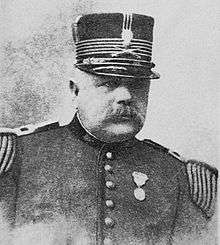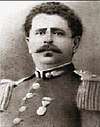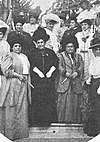Ángel Canavery
Angel Mateo Canavery (1850 - 1916) was an Argentine military man, who participated in the Argentine Civil War and Conquest of the Desert.[1] He took part against the Montoneras of Ricardo López Jordán (Rebelión jordanista), and against Civic Union troops during the Revolution of the Park.[2]
Ángel Mateo Canavery | |
|---|---|
 | |
| Birth name | Ángel Mateo Canavery Castillo |
| Born | September 21, 1850 Buenos Aires |
| Died | July 20, 1916 (aged 65) Buenos Aires |
| Buried | Recoleta Cemetery |
| Allegiance | |
| Service/ | |
| Years of service | 1870-1905 |
| Rank | Lieutenant colonel |
| Commands held | Regimiento de Infantería de Línea Nº 1 |
| Battles/wars | Jordanist Rebellion Conquest of the Desert Revolution of 1880 Revolution of the Park |
| Spouse(s) | Mercedes Montero |
| Signature | |
He also served as military attache in the Kingdom of Italy in 1889, during the presidency of Miguel Ángel Juárez Celman.[3]
Military career

He was born in Buenos Aires, the son of Tomás Canaverys and Macedonia Castillo, belonging to a patrician family of Irish and Creole roots.[4] He did his primary and secondary studies in the city, and began his military career as second lieutenant in the 8th Infantry Battalion, to the orders of Lieutenant colonel Tomas Elliot in 1873.[5]
He participating in the end of the Campaign against Ricardo López Jordán in Entre Ríos. Later he served in the military Garrison of Mercedes, province of Buenos Aires. He was discharged from the army for personal reasons in 1875.[6]
He was reincorporated into the ranks of the army in 1876,[7] serving in the Fuerte General Lavalle (current General Pinto) and Puan. In 1877, with the rank of first lieutenant, he served in the 1st Line Regiment,[8] under orders of Colonels Teodoro García, Nicolás Levalle and General Julio Argentino Roca.[9]
During the military expeditions he participated in the assault on the tribes of Catriel in "Treyco Grande" (La Pampa), and in the operations against the tribe of Namuncura in Chiloé (La Pampa).[10] Later he took part in the Battle of Hucal Grande against the tribes of Cañumil and Huenchuquil (occurred in 1878).[11]
Lieutenant Canavery took part in the military actions of December 6 and 7, 1878, in which the Argentine Army confronted the tribe of Namuncura in Lihué Calel.[12] In 1879 he provide services in the garrison of Choele Choel and participates in the actions commanded by Gral. Roca, on the banks of the Río Negro.[13] That same year he fell ill from a gallbladder condition, being cured by a female healer who had also attended General Teodoro García in Puan.[14]
He maintained a respectful deal with Aboriginal leaders who participated in the Conquest of the Desert, and also with the main Caciques who fought against the Army troops during the Military Campaigns. According to some historians, Canavery would have been honored by chief Catriel with a poncho.[15]
After finishing his services in the Argentine south, Ángel Canavery returned to Buenos Aires, being promoted to captain on April 1, 1880.[16] A year later he served in Salta to the orders of Colonel García, until June 5, 1882.[17] That same year Canavery provides services in the Infantry Inspection, being promoted to major in 1886, and appointed as Military attaché from Italy in 1889.[18] Returning to Argentina a year later, he was promoted to lieutenant colonel in August 1890, serving in the Estado Mayor del Ejército.[19]
Between 1892 and 1895, Canavery was in charge of the military detachment of Santa Catalina and served as commander of the detachments of Córdoba and San Luis until 1900.[20] In 1896, he went on to serve in the Plana Mayor Activa.[21]
He also intervened in civil-military conflicts in Argentina, including the Revolution of 1880 and Revolution of the Park, taking part in the main actions against the revolutionary troops.[22]
Until the middle of the 19th century the troops of the Argentine army had used sabers and spears, and rifles of a single shot. In 1879, the officers and soldiers of the army were equipped with modern weapons that included Remington rifles, Carbines[23] and Lefaucheux pistols,[24] used by Canavery during his military career.
He was a colleague of distinguished Argentine officers with whom he participated in various military campaigns, including Carlos O'Donnell, Carlos Smith, Francisco Smith, Lorenzo Tock and Augusto Rouquaud. In 1902, he attended the funeral of Juan de Dios Rawson, a lieutenant colonel who participated in the Paraguayan War.[25]
He retired from the army with the rank of lieutenant colonel in 1905.[26] He was a member of the Club del Progreso, the first gentlemen's club in South America.[27]
Family


Ángel Canavery was married on April 3, 1880 in the parish Basílica Nuestra Señora del Pilar to Mercedes Montero, daughter of Apolinario Montero and Julia Rondó, members of a distinguished family related to José Rondeau. His wife was in charge of the Sociedad Protectora de Huérfanos de Militares (Society of Military Orphans),[28] a charitable association founded on July 12, 1891.[29]

He had several brothers including, the Colonel Tomás Canavery,[30] a hero of the Battle of Lomas Valentinas during the Paraguayan War. His nephew was General Enrique Mosconi Canavery, who served as director of the Yacimientos Petrolíferos Fiscales between 1922 and 1930. A great-granddaughter of his sister Juana María Canavery, was related to a descendant of Luis Vernet, governor of the Islas Malvinas in 1830.[31]
A large part of Angel Canavery's relatives served in the ranks of the army, taking part during the English invasions, the War of Independence, the Argentine and Uruguayan Civil War and the Military Expeditions against the indigenous incursions.
His paternal grandfather Mariano Canaverys, whose father (Juan Canaverys) participated in the May Revolution, was a teacher who served as lieutenant of the 1st squadron of Hussars of Pueyrredón, having an active participation in the defense of Buenos Aires during the English invasions. Outside of Argentina in North Italy and South France there are some records about members of the Canavery family associated with military campaigns, including the services rendered to the French Army during the Napoleonic period by Joseph Canavery, born in Stura, Piedmont, who served as a rifleman of the Battalion Vélites of Turin.[32]
He attended numerous meetings of the local aristocracy, including the held in the Circulo Militar in honor to General José Ignacio Garmendia.[33]
Canavery and his wife did not have children, but were the godfathers of baptism of Carmen Canaveri, daughter of Saturnino Canaveri and Carmen Canavery.[34]
Ángel Mateo Canavery died on 20 July 1916 in Buenos Aires.[35] His wife Mercedes Montero in the same city in 1930.[36]
References
- Congreso Nacional de Historia sobre la Conquista del Desierto, Academia Nacional de la Historia, 1982
- Mosconi, general del petróleo, Raúl Larra, 1976
- Historia, Números 89-92, Ediciones AP, 2003, 2003
- San Telmo: su pasado histórico, Ediciones República de San Telmo, 1965
- Biografías argentinas y sudamericanas: A - B - C, Jacinto R. Yaben, 1938
- Nuevo diccionario biográfico argentino: 1750-1930, Volumen 1, Vicente Osvaldo Cutolo, 1968
- Memoria del Ministerio de Guerra y Marina presentada al Honorable Congreso por el Ministro de Guerra y Marina, Argentina. Ministerio de Guerra y Marina, 1881
- Revista de la Junta de Estudios Históricos de Mendoza, Junta de Estudios Históricos de Mendoza (Argentina), 1975
- Enrique Mosconi. Planeta. 2001. ISBN 9789504908319.
- El cacique Namuncurá: último soberano de la Pampa, Adalberto A. Clifton Goldney, 1956
- Ocupacíon de la llanura pampeano, Carlos María Gelly y Obes, Ramón Melero García, 1979
- Vida del teniente general Nicolás Levalle, Héctor Juan Piccinali
- Patagonia: boletín de la Casa de la Patagonia, La Casa
- La mujer en la Pampa: siglos XVIII y XIX, Angel Domínguez e Hijo, 1958
- Mosconi, petróleo para los argentinos. Jorge Victoriano Alonso, José Luis Speroni.
- Memoria, Part 1, Argentina
- Memoria, República Argentina
- Registro nacional de la República Argentina que comprende los documentos expedidos desde 1810 hasta 1891 ..., Volume 12. Argentina. pp. 14 v.
- Registro nacional de la República Argentina, Argentina
- Colección de leyes y decretos militares concernientes al ejército y armada de la República Argentina, Volume 4, Ercilio Domínguez
- Registro Nacional (1896), Argentina
- Biografías argentinas y sudamericanas, Jacinto R. Yaben
- La conquista del desierto, Bartolomé Galíndez
- Revista, Volume 45, Círculo Militar (Buenos Aires, Argentina)
- Necrología, Caras y Caretas
- Registro nacional de la República Argentina, Parte 5, Registro oficial1810-1856, Argentina, 1810
- Guía biográfica, Hogg, Ricardo, 1904
- Revista, Volume 14, Círculo Militar (Buenos Aires, Argentina)
- Argentina médica, guía médica é higiénica, Imprenta y casa editora de Coni Hermanos
- Historia eclesiastica argentina, Editorial "Huarpes", 1945
- Greenleaf Cilley y Prince & Malvina Vernet y Sáez, Genealogía Iralndesa
- Joseph Canavery, République française
- En el Pabellón de los Lagos, Caras y Caretas
- Bautismos 1898, Parroquia Inmaculada Concepción
- Gran enciclopedia argentina by Diego Abad de Santillán, Ediar, 1956
- Revista, Volume 30, Círculo Militar (Buenos Aires, Argentina)